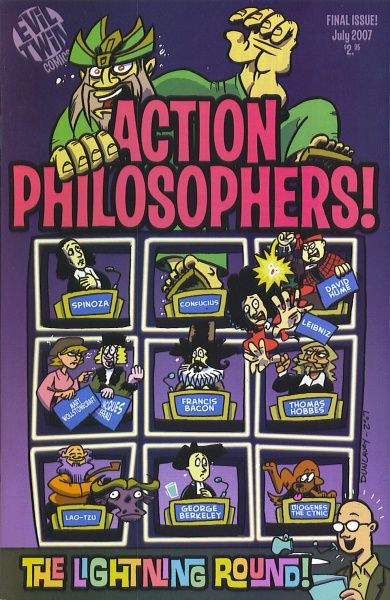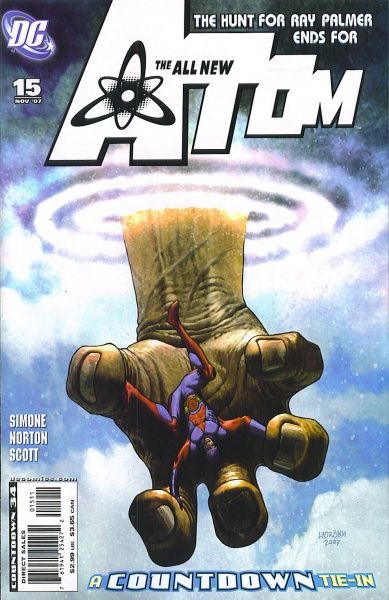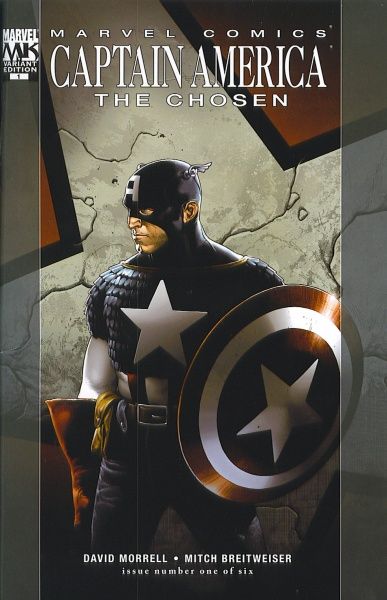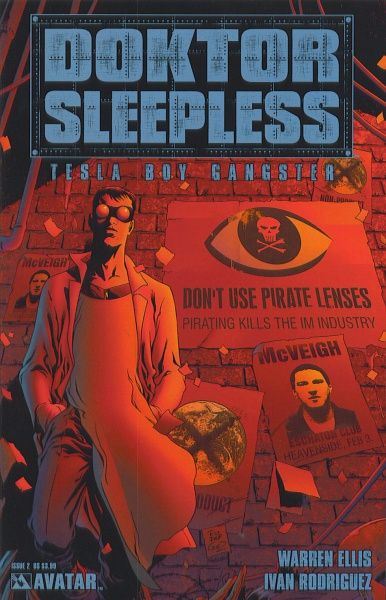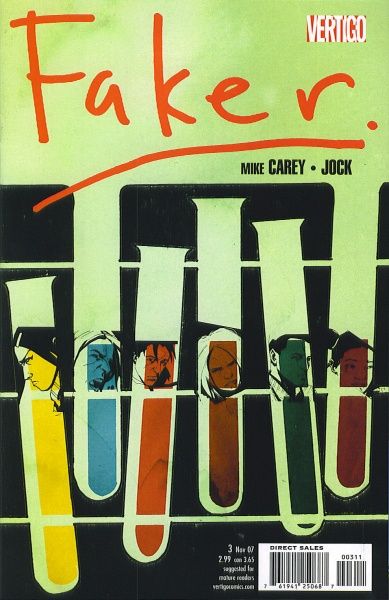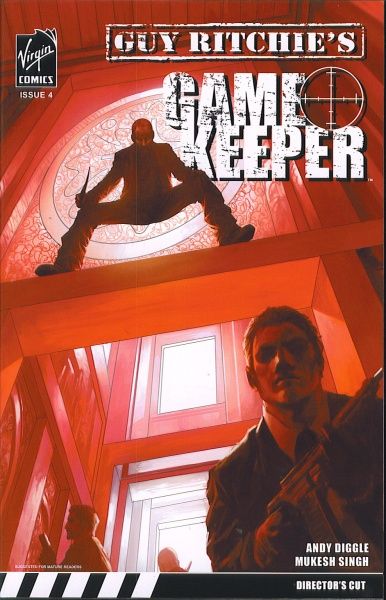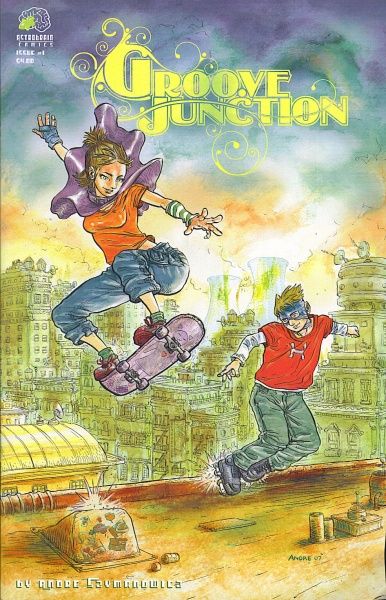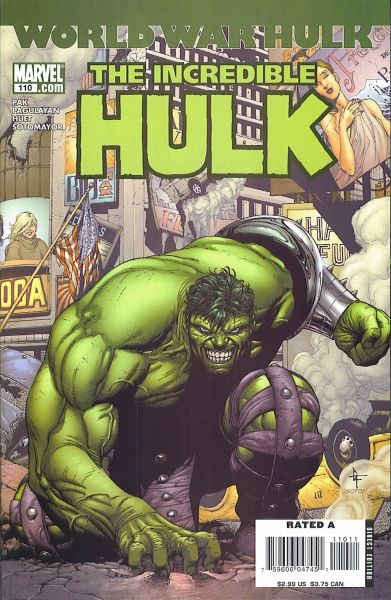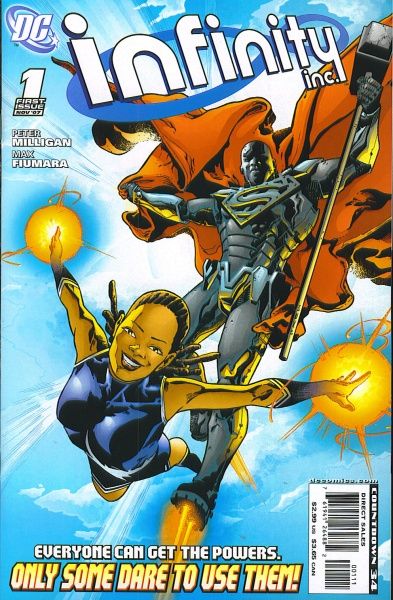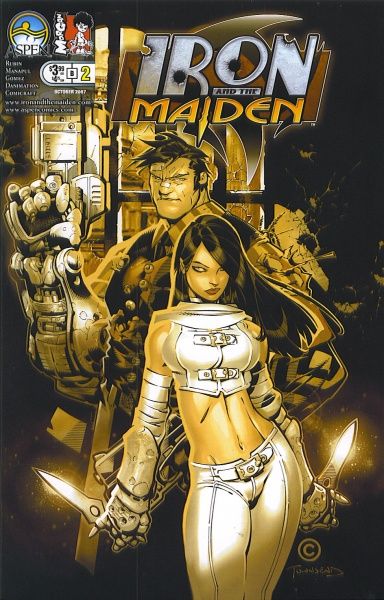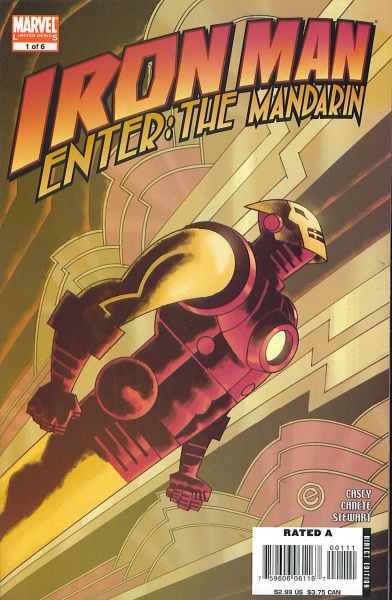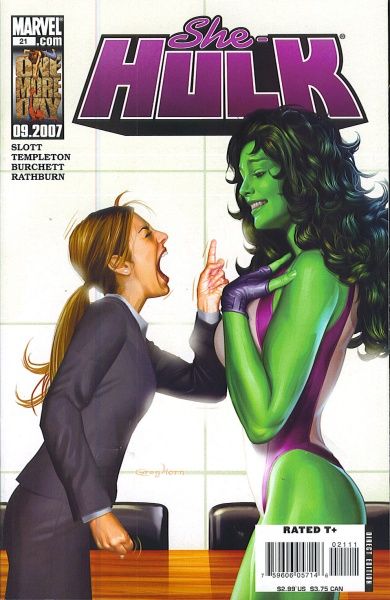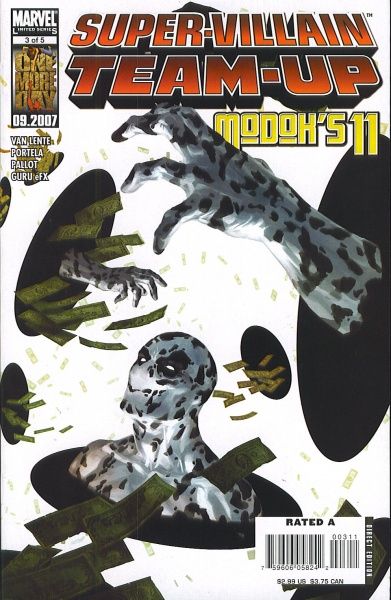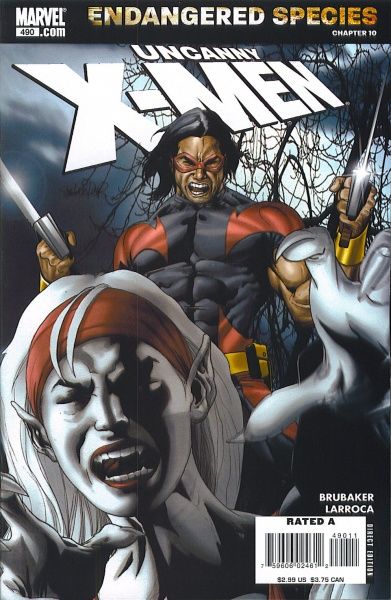Some interesting stuff this week, including the end of a great series, the beginning of what might be a great one, plus ... Greg gets defensive! Isn't that always fun?
Action Philosophers! #9 by Fred van Lente and Ryan Dunlavey. $2.95, Evil Twin Comics.
Ah, Action Philosophers! What a fun trip you've taken us on. The final issue of this fantastic series features several new philosophers, and it's as funny as the rest of the series. One of the nice things about AP! is that van Lente and Dunlavey not only educate, but present the material in such interesting ways. Therefore, we get "The Foucault Circus," a parody of "The Family Circus;" a King Kong parody with Confucius; "6 Degrees of Francis Bacon;" and a situation comedy starringJean-Jacques Rousseau called "Oh No, Rousseau!" It's a very funny and enlightening book, and Igreatly encourage you to find an issue and read it. Plus, the third trade will be out later this year, collecting issues #7-9, and thosetrades are good value. Van Lente is writing everything these days (including one book below), but he and Dunlavey are working on two new projects that are sure to be as entertaining as this one has been (including Action Presidents!). So check them out when they show up!
TheAll-New Atom #15 by Gail Simone, Mike Norton, and Trevor Scott. $2.99, DC.
I'm going to be a bit grumpy and defensive now, if you don't mind. I endure taunts when I purchase something like, say, Moon Knight or Doktor Sleepless (see below), yet if I pick on something you like, I get all sorts of comments saying I just don't get it and how stupid I am. Take this book, for instance. It's just mediocre. It's certainly not as funny as people think it is, and it seems like Simone is really trying too hard. She's certainly funny - I would love to read something by her like her old column You'll All Be Sorry, where she can savage the DC or Marvel Universe. But this book just isn't it. The Anson Williams joke is forced, and was funnier the first time a comic book character was obsessed with Potsie, in Scurvy Dogs. Plus, it's all over the map. There's a quest for Ray Palmer at the beginning of the book, when suddenly Ryan is dragged back to Ivy and that particular plot is simply dropped (and yes, I realize it is "continued" in Countdown, but we've had, what, two - possibly three -issues of it here, and then it suddenly shifts to a different book? Lame). Then we get the Japanese movie monsters, and I wonder who the geek is that will recognize them? Simone seems to want to write a slightly off-kilter superhero story, but then she has people like Dwarfstar hanging around butchering people. It all adds up to a mush of silliness that cracks under the pop culture references and doesn't have anything interesting to say about anything. And the quotes byvarious scientists and such have gotten more annoying as we've gone along. I've tried to enjoy the book, really. The first trade wasn't great, but it wasn't bad. The book just goes nowhere, though, and you can bash Mr. Ellis all you want, but at least something like Doktor Sleepless is trying to do something instead of just making bad jokes.
Captain America: The Chosen #1 (of 6) by David Morrell and Mitch Breitweiser. $3.99, Marvel.
Breitweiser's art is the star of the show here, as he gives us a gritty and war-torn Afghanistan and brings home the brutality of life during wartime. Despite the lack of a lot of coloring, the early scenes are very gripping, and when Captain America shows up, his red, white, and blue really pop off the page (Brian Reber did the colors on the book). It's a nice book to look at.
Which is a good thing, because Morrell is definitely writing for the trade. It's an interesting set-up, as Corporal James Newman wanders through a village shooting bad guys and despairing because he's no longer sure who he's supposed to shoot and who he's supposed to protect. When he can't bring himself to shoot a man and a woman, Cap shows up and tells him all the good stuff about honor and courage, and helps him rescue a comrade who's trapped. But then we learn that only Newman saw Cap, and nobody believes that he was there. We end with Cap on a stretcher with all sorts of tubes in him, watched by Nick Fury and some S.H.I.E.L.D. chippie. Is Newman real? What's going on? This, at least, explains why Cap was able to read Newman's mind earlier in the book.
Like I said, it's an intriguing premise, and Morrell does a nice job with it. I just don't think it's worth spending 4 bucks for six issues when you know we'll get a nice trade for 20 dollars, probably. But it's a neat start.
Doktor Sleepless #2 by Warren Ellis and Ivan Rodriguez. $3.99, Avatar.
Do I love Doktor Sleepless? No. Is this book interesting? Sure. Is it Warren Ellis doing his Warren Ellis thing? Well, of courseit is. But it's still trying something relatively different in comics, and it's intriguing. What is the secret of the multiple Doktor Sleeplesses? What is this Doktor Sleepless actually doing? The thing with Ellis is that if you don't like what he's doing, that's fine. But he does it very well. And, like the best writers out there, he knows exactly when and where to drop a bit of humanity into his books that gives you a slight chill. He did this a lot in Transmetropolitan, which this book probably resembles the most, and he does it in this issue. The shrieky girls are a pretty cool idea, and when John narrates, "Two, three hundred shrieky girls smile just a little bit and hold an invisible hand for a while ... Twenty, thirty thousand shrieky girls smile just a little bit and turn away to dance," it's a beautiful moment in the book. You may like All-New Atom more (that's your choice), but nothing in Simone's writing in the latest issue comes close to that little bit of humanity. That's why I give Ellis books a chance. Might I drop this book? Sure. It's 4 dollars, which is a bit steep, and it could easily go off the rails. But it's the way Ellis just gets relationships that make his comics fascinating to read. Strip away the techno-futuristic junk (which can get tedious occasionally), and you get to devastating portrayals of the way people interact with each other. And that's what is at the heart of great fiction. Not pop culture references, not cool costumes, not bigger-than-life conflicts. Ellis is as guilty as anyone else at doing those, but here, he's not. So I'm going to keep buying it, until he stops doing that.
Faker #3 (of 6) by Mike Carey and Jock. $2.99, DC/Vertigo.
Carey continues to write a gripping story with absolutely no likable characters, which is a handy trick. I really can't stand any of these people, but the pickle they're in is neat, and Marky's comments about human nature are nicely done. Plus, there are a couple of plot twists that keep the book going: who Kate Dhu is calling on the phone after Marky dumps her, and Sack's musing that Nick doesn't really exist and their group is hallucinating him. Those two things, along with the overall mystery of what happened the night they all partied, keep the book intriguing. I don't care a whit if all these characters meet horrible fates (and in the case of Jessie, I might actually be rooting for it), but how they will meet horrible fates will keep me coming back. I guess I'm sadistic.
Two things: I like how Nick has a poster of The Losers on his wall. Nice touch by Jock. And I also like that this is a Vertigo book and the characters swear like longshoremen, but they don't show the nipple in one panel. As someone long ago wrote into an early Vertigo book (can someone help me out, if you recall the letter?): "You have a Mature Label. Use it." More nudity, DC!
Gamekeeper #4 (of 5) by Andy Diggle and Mukesh Singh. $2.99, Virgin.
This came out two weeks ago, but they just got it at my comics shoppe. There's not much to say about it. Brock watches his quarry, who is getting squeezed by the men he was dealing with because he doesn't have what they want. And we learn more about what happened with Brock's son years earlier. It's nice and violent.
So everything is set up for a suitably horrific ending. I'll be looking forward to it.
Groove Junction #1 (of 3) by Andre Szymanowicz. $4.00, Astro Brain Comics.
I reviewed a part of this comic back in May, when it appeared in an anthology book, and Szymanowicz was nice enough to send me the entire thing. This is a true independent book in every sense of the word - Szymanowicz is selling it through his web site, the link to which I provided above. So if it sounds intriguing, head there and buy it. Yes, it's four dollars, but won't it give you a warm glow all over to support such a book?
But is it any good? Well, it's not bad. We're introduced to the town of Groove Junction, where everything runs on "ambient energy," which is free and unlimited. Pretty handy. The story concerns two teenagers, one of whom, Gabe, we met in the earlier anthology. He is a typical teenager, in that he worries about life a lot. One of things he worries about is whether he should be more heroic, which starts with helping people out when they're doing regular things. He talks to his friend about seeing an old woman struggling with groceries, and how he agonized over helping her so long that she had already reached her home. Gabe says his friend wouldn't have done that, and he wants to be more like him. It's a nice scene, made even nicer when Szymanowicz reveals that Gabe's friend is really his own reflection in the mirror, only with a mask on. The idea that masks make us heroic is not terribly original, but it's handled well here. The next chapter deals with Sam Nikel, a teenaged girl who zips around town on her skateboard wearing a mask. She rescues a dog, then flees from a store robbery when the bad guys spot her. The book ends with her smashing into Gabe as she's getting away. Sam actually does something heroic (save the dog) but she's also not a hero, as her flight from the robbery makes clear. It's an interesting set-up, and I'm curious about where it's going.
Szymanowicz is pretty obviously an artist before he's a writer, because his art, while somewhat rough, has nice energy and a good sense of place. He does a good job making his principals look like teens, and doesn't have a difficult time shifting from quiet moments to action. His writing is adequate - it's a bit clunky at times, but there's nothing wildly egregious that will detract from the story. Like a lot of writers who aren't confident with their voice yet, occasionally the narration is a bit heavy-handed, but again, it's not to the point where it becomes annoying.
It's a neat little comic that has a lot of potential. I'm glad I read it, so that's something!
The Incredible Hulk #110 by Greg Pak, Carlo Pagulayan, and Jeffrey Huet. $2.99, Marvel.
Pak does a nice job here trying to figure out how he's going to get out the mess he's made - namely, that the Hulk will not kill everyone on the planet. Amadeus Cho, who is becoming a really neat character, proves that the Hulk isn't going to kill anybody, and although his explanation about why the Hulk hasnever killed anybodystretches logic just a tad, it's still pretty decent. That's pretty much the entire issue - Cho explaining to the Hulk why he's not going to kill anybody. It sounds dull, but Pak does a good job incorporating some action, and the brief trip down the Hulk's memory lane is nicely handled. I'm not entirely sure how Pak can get out of it now that we're sure the Hulk isn't going to kill anybody (as if we didn't know before), but it'll be interesting to see what he comes up with.
Infinity, Inc. #1 by Peter Milligan and Max Fiumara. $2.99, DC.
I was absolutely blown away by the first issue of Infinity, Inc. Now, of course, I'm a fan of Peter Milligan, but that doesn't mean everything he writes is good, and this book, set in the mainstream DCU, has the potential to be, well, Elektra (man, that sucked). But Milligan has his phasers set on "weird" for this first issue, and this rocks. I hope everyone buys it so Milligan can continue being freaky for a long time.
Milligan tells the story of Natasha Irons, Steel's niece, Erik Storn, and Gerome McKenna, who were given superpowers by Lex Luthor and sent out as Infinity, Inc. A year ago, however, Lex turned their powers off, and now Steel is trying to find them to help them deal with life after Infinity. This just helps Milligan establish the characters, a threat to them, and bring in a favorite theme of his: psychoanalysis. Natasha is seeing a therapist. The bad guy is seeing a therapist. Erik is seeing a therapist. Gerome is seeing a doctor when we first visit him, and he probably ought to see a therapist, considering what happens. Milligan loves writing books in which the characters are simply out of sync with the "normal" people of the world, and even in this book, which deals with fairly odd superpeople, the superpeople are even a bit crazy. Erik even responds to Steel's question about therapy with, "It's our n-national religion, isn't it?" Milligan remains strange, but he doesn't allow it to overwhelm the story, as the weird writers sometimes do. When something odd happens to Natasha at the end of the book, the strangeness of it doesn't overwhelm the terror both she and Steel feel. When the bad guy does bad things, it's scary without going too far. And Gerome's problem, while a bit extreme, isn't beyond the realm of possibility. If Milligan continues to walk this fine line, this could easily be an excellent run.
Fiumara's art certainly helps. The only time I've seen it is on My Flesh is Cool, an Avatar mini-series from a few years ago (written by Steven Grant, in case you're interested). The colors really help to make the art pop off the page (even though the pencils are good, too). Natasha's fall through a window is made even more disturbing by the cuts on her body (nice to see someone remembering that falling through a window slashes your body up, something action movies have forgotten). Right after the bad guy does something horrible, Fiumara's panel of him moving onto his next victim is truly terrifying. And the final page is wonderfully done. Let's hope this gets a good artist some nice recognition.
Give it a try, people! What have you got to lose?
Iron and the Maiden #2 by Jason Rubin, Francis Manapul, and Joel Gomez. $3.99, Aspen Comics.
I read the first issue of this series and hated it, so why would I read the second one? Well, that's the great thing about reading comics for free - you can read crap like this and not feel too bad! I'm not even going into the story, because it's amazingly stupid. I'm just wondering - how do people like Rubin and Manapul get work? I don't like being somean, but this demands it, because Rubin's script is just awful. He just piles cliche on cliche (this is a gangster-cyberpunk-revenge story, by the way), from the big lunk with a decent soul to the widow stripping to get inside and take her revenge to the corrupt churchmen to the ... you get the idea. None of it is particularly interesting, and what's more, Rubin doesn't have a terribly good writing style to gloss over the dullness of the story. So how is he employed?
Meanwhile, Manapul's art is in the worst style of Image excess. Hugely muscular men, women with ridiculously tiny waists and great breasts, and ridiculously stereotypical deformedgangsters (midgets with giant glasses, for instance). There's absolutely no sense of style - everything is flat, the faces are vacuous, and everything is grotesque. You might hate Bachalo, but that cover has more energy than the entire issue put together. I would ask how Manapul has a job, but guess what? He's going to be the new artist on Legion of Super-Heroes. Sheesh. Someone at DC thinks this is good art, but that book is going to suck. If you're a Legion fan, pick this issue up (dear Lord, don't buy it) and check out how ugly LSH is going to be.
Iron Man: Enter the Mandarin #1 (of 6) by Joe Casey and Eric Canete. $2.99, Marvel.
I'm thinking about ditching all DC and Marvel mini-series in favor of the trades, because that's just how I roll. So I didn't buy Captain America: The Chosen, and I didn't buy this book. I also didn't buy Metal Men #2, even though I liked issue #1, because the first issue was so dense (and, if Tom Foss is to be believed - and why wouldn't he be? - full of horrendous science) that I want to read it all at once. But I picked this up just to see if it was any good. Why not?
Well, it vindicates my wait-for-the-trade policy with regard to mini-series, because it's all set-up. It's not bad set-up, but it all leads to Iron Man and Mandarin facing off for a big fight next issue. Canete's art is wonderful - rough and quirky and full of energy. A hard thing to do with Iron Man is to give him personality, simply because he's wearing a metal suit, but Canete manages it. Very cool.
The biggest problem I have with this book is one that Mandarin himself expresses: Why send Iron Man to do this job? Well, I don't know if Casey has a good reason, but it's one of the reason I don't necessarily like these "origin" mini-series: Mandarin is Iron Man's bad guy, so of course S.H.I.E.L.D. has to send Iron Man, even though it's kind of silly. Back in the day, it just happened that whoever created Mandarin wanted him to fight Iron Man, and others picked up on that and he became Iron Man's bad guy. That makes things like this not as strong as it could be, because Casey, like a lot of writers in the shared universe, is relying on our prior knowledge of their relationship to make this work. It doesn't make the book bad, it just weakens it a bit. That's why I'm not the biggest fan of these kinds of books. But it might work out in the end!
She-Hulk #21 by Dan Slott, Ty Templeton, Rick Burchett, and Cliff Rathburn. $2.99, Marvel.
I don't get this. I mean, I understand what Slott is trying to do, but it doesn't seem to solve the continuity problems, and I'm sure I'm missing many of the jokes because I don't know Marvel history as well as Slott does. I guess I'm supposed to go back over my She-Hulk issues and try to puzzle out which times She-Hulk was this Earth's as opposed to the other Earth's, but I just don't care all that much. I'll probably do that eventually, but right now, I don't care. Anyway, how does this solve anything? Remember, whether Joey Q likes it or not, there are several other dimensions in Marvel continuity, so what does this do? I'm sure Slott is not suggesting this as a "real solution," so it's odd he even delves into it. I guess the solution to Jen's personal problem is handled as well as can be expected,and overall, it's a pleasant enough issue to read as a final one, and the Peter David joke is pretty funny. It goes back to what I was curmudgeonly about with all the Wolverine appearances - only certain writers like Slott care about continuity anymore, and it doesn't really pay to worry about it.
I haven't read Brian's review, but judging by the comments, a lot of people have a lot to say about this, so I'll just leave it at that and direct you there. Other than that, this is just a reset button. It's a sweet issue from a guy who was done a nice job (for the most part; we won't talk about Starfox and the Agent of S.H.I.E.L.D. stories) for 33 issues of a title. And that's okay.
Super-Villain Team-Up #3 (of 5) by Fred van Lente, Francis Portela, and Terry Pallot. $2.99, Marvel.
Well, the heist goes horribly wrong. I know, shocking. It's the middle issue, so it's kind of difficult to really talk about it. I mean, we had the set-up, and the heist is fun because it seems to be going well until Thomas Fireheart's tribe decides to take his powers away and yet another member of the gang betrays them. It's interesting that Van Lente is managing to show how competent these bad guys really are, and it's only their horrendous morals that keep them from achieving their goals. He doesn't take them too seriously, but he doesn't make them the butt of jokes, either. There's one thing I don't get, and I hope y'all can help me out: Puma, Laser, and Chameleon (who's not really the Chameleon), stumble into a room and Puma says, "This explains a lot ..." They're staring at a girl floating in a pillar of light surrounded by a bunch of M.O.D.O.K.s. What the devil (as Brian might say)????? That doesn't explain anything, Puma!!!!! What is going on, comic nerds around the world? Help your stupid reviewer!
Uncanny X-Men #490 by Ed Brubaker and Salvador Larroca. $2.99, Marvel.
I have been warming up to Brubaker's run on this book as he continues to make this book into his own, as I hoped I would. This issue does a nice job continuing the Morlock storyline, as Hepzibah andJames try to find the Morlocks, and when they do, things go poorly. Meanwhile, Storm, Skids, and Caliban discover more about the prophecies of an insane mutant who saw a bright future for mutants. Unfortunately, that future didn't include Storm, Skids, and Caliban, or at least that's what her disciple tells them, just before Masque shows up to wreak havoc. Brubaker does a nice job with the fight scenes as well as the creepiness of Qwerty, the mutant seer, and Delphi, her disciple. The final page is really scary -a nice touch by Brubaker, and Larroca, whose art is fine, makes Storm a picture of fear. Despite not really liking the characters Brubaker is using, he's doing a good job making this a comic his own. And a Brubaker comic, instead of a comic that happens to be written by Brubaker, is a good comic.
I have to say that I don't like Magneto's outfit on page 1. I mean, I know purple is his thing, but a purple trench coat and a purple fedora? Really? Stacy and Clinton would be scandalized.
That's it for another week. Lots of good stuff. Comics are, after all, awesome.


